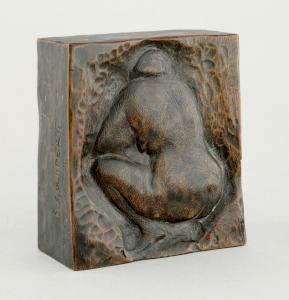Simon Goldberg (1913-1985)
Simon Goldberg was born October 7, 1913 in Paris. His father, born in Austria, was a tinsmith, and his mother, born in Algeria, was a tapestry weaver. In 1926, at the age of 13, he began studying drawing and sculpture in the studio of Elysée Cavaillon, who had once belonged to the Bande à Schnegg. There he studied drawing and sculpture, and a year later, was introduced to sculpting in wood by Louis Rueff. From 1931 on, he studied at the Ecole des Arts Appliqués (School of Applied Arts), taking modeling courses from Robert Wlérick and drawing from Charles Malfray.
In 1938, he organized an exhibition of his works with his friend Raymond Corbin. The State bought some of his drawings for the museums of Nevers, Valence, and Granville, and also commissioned the stone sculpture Seated Woman. During the Second World War, he took refuge in the Ardèche, in Saint-Martin de Valamas, and in 1948, was commissioned to create the Monument to the Memory of the Resistance near the town of La Charité sur Loire. This was followed in 1951 by a commission for a stone monument for the city of Saint-Etienne titled Reclining Man. In 1952, the State acquired his wood bas-relief Repose, and in 1954, the city of Paris bought another, his Seated Nude. Toward the end of the 1960s, the Paris Mint commissioned him to make twenty-three medals, which he worked on over the next ten years. They featured Georges Bizet, Jean-Baptiste Boussingault, Camille Corot, Honoré Daumier, Federico Fellini, Jean Renoir, and others.
Goldberg was also an engraver and illustrated several books, including Les Philippe by Jules Renard (1947), Petits poèmes en prose by Charles Baudelaire (1955), La pension Marie Stuart by Pierre Mac Orlan (1957), L’Enfant et la Rivière by Henri Bosco (1960), and Les amours by Pierre de Ronsard (1966). In 1955, he was given a grant to spend eight months in the Descartes House in Amsterdam, which gave him the opportunity to execute a series of monotypes. The Rijkmuseum in Amsterdam and the museums of Leyden and Utrecht purchased some of his drawings and engravings. During the same period, he had a one-man show of his monotypes in the Dutch capital. 1958, the Print Collection of the Bibliothèque Nationale (the National Library) acquired six of his engravings; they now hold forty-six.
In the 1970s, he began to receive recognition through awards, such as the Prix d’Aumale, given by the Institute of France (1978). He regularly participated in various salons, including the Salon d’Automne, and those of the Tuileries, of drawing and watercolor, of French Artists, and of the Rosicrucians. He died in 1985 at the age of 71.




